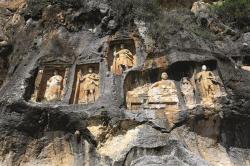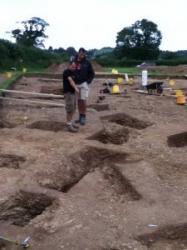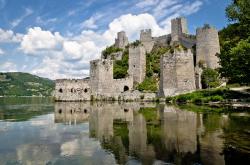INSTITUT SUPERIEUR D'ANTHROPOLOGIE
INSTITUTE OF ANTHROPOLOGY
ONLINE COURSES / COURS A DISTANCE
SUMMER TERM : JULY 2014
REGISTER NOW
TURQUIE -  Şeytan Deresi Valley -The Adam Kayalar (man-rocks), located on the sheer slopes of the Şeytan Deresi Valley in the southern province of Mersin, often take visitors by surprise with their large-scale human reliefs, which are estimated to have been made between the first century B.C. and the second century A.D. The rocks are made up of 11 males, four females, two children, an ibex and Roman eagle reliefs in nine niches.As the Adam Kayalar region was once considered a sacred area, the reliefs of notables or commanders’ families and children were made on the rocks to show appreciation. The reliefs are thought to have been made over the course of around 250 years. “As it was considered a sacred area, reliefs were made on the rocks over many years, so you can see the many stylistic changes of the figures,” Aydınoğlu said.“People settled here in order to take the valley roads to the hinterland under control. When you look at the settlement places from above, you see that the hill is surrounded by city walls. It can be understood that it was a military headquarters with many structures inside. This headquarters control the roads. In the Hellenistic era, there were many castles like this through this line. The Adam Kayalar are in one of the castle settlements we know. Both passersby and the people who used the valley road for commercial purposes could be controlled easily in the place where the reliefs are located,” he said.
Şeytan Deresi Valley -The Adam Kayalar (man-rocks), located on the sheer slopes of the Şeytan Deresi Valley in the southern province of Mersin, often take visitors by surprise with their large-scale human reliefs, which are estimated to have been made between the first century B.C. and the second century A.D. The rocks are made up of 11 males, four females, two children, an ibex and Roman eagle reliefs in nine niches.As the Adam Kayalar region was once considered a sacred area, the reliefs of notables or commanders’ families and children were made on the rocks to show appreciation. The reliefs are thought to have been made over the course of around 250 years. “As it was considered a sacred area, reliefs were made on the rocks over many years, so you can see the many stylistic changes of the figures,” Aydınoğlu said.“People settled here in order to take the valley roads to the hinterland under control. When you look at the settlement places from above, you see that the hill is surrounded by city walls. It can be understood that it was a military headquarters with many structures inside. This headquarters control the roads. In the Hellenistic era, there were many castles like this through this line. The Adam Kayalar are in one of the castle settlements we know. Both passersby and the people who used the valley road for commercial purposes could be controlled easily in the place where the reliefs are located,” he said.
http://www.hurriyetdailynews.com/a-hidden-treasure-in-the-mediterranean-the-man-rocks.aspx?pageID=238&nID=65128&NewsCatID=375
ROYAUME UNI –  Salisbury - A rare Roman mosaic is being installed at the new Wessex Gallery of Archaeology at SalisburyMuseum.The Downton Mosaic is a well-preserved mosaic floor which was part of a fourth century Roman villa. The intricately patterned mosaic was uncovered in the late 1950s on a new housing development in Moot Close, Downton. It is the first exhibit to be installed at the new gallery, which opens this summer, and it is expected to take about three weeks to put in.
Salisbury - A rare Roman mosaic is being installed at the new Wessex Gallery of Archaeology at SalisburyMuseum.The Downton Mosaic is a well-preserved mosaic floor which was part of a fourth century Roman villa. The intricately patterned mosaic was uncovered in the late 1950s on a new housing development in Moot Close, Downton. It is the first exhibit to be installed at the new gallery, which opens this summer, and it is expected to take about three weeks to put in.
http://www.salisburyjournal.co.uk/news/11151702.Downton_mosaic_installed_at_Wessex_Gallery/
INDE –  Pattanam - Oxford archaeologists working at Pattanam, located 25 km north of Kochi, have confirmed that it was an Indian port frequented by Romans and have put to rest doubts about the antiquity of the site. If the excavations and surveys go as planned, the UK team might also have answers to questions such as why Pattanam was chosen to create a major trading facility and how the once flourishing city disappeared. Pattanam has a long history of habitation dating back to 10 century BCE and its trade links with Rome peaked between 1st century BCE and 4th century CE. Some experts have identified Pattanam as part of the lost port town of Muziris described in ancient Tamil and Roman texts. The UK experts plan to use airborne surveying techniques such as LIDAR (Light Detection and Ranging) to map and understand the surface characteristics of this settlement.
Pattanam - Oxford archaeologists working at Pattanam, located 25 km north of Kochi, have confirmed that it was an Indian port frequented by Romans and have put to rest doubts about the antiquity of the site. If the excavations and surveys go as planned, the UK team might also have answers to questions such as why Pattanam was chosen to create a major trading facility and how the once flourishing city disappeared. Pattanam has a long history of habitation dating back to 10 century BCE and its trade links with Rome peaked between 1st century BCE and 4th century CE. Some experts have identified Pattanam as part of the lost port town of Muziris described in ancient Tamil and Roman texts. The UK experts plan to use airborne surveying techniques such as LIDAR (Light Detection and Ranging) to map and understand the surface characteristics of this settlement.
http://www.thehindu.com/news/national/kerala/oxford-archaeologists-unravel-the-past-of-pattanam/article5916882.ece
ROYAUME UNI –  Ipplepen -This year’s fourth season at Ipplepen in Devon, run by the University of Exeter, will return to the Roman road and associated burials revealed in 2011. and a complex series of enclosures and structures thought to be part of the largest Romano-British settlement in Devon outside of Exeter. Geophysical survey and a significant number of Roman coin finds have highlighted the importance of this extensive site and its potential to explore the relationship between Roman Britain and its native population. Last year’s field school revealed an Iron Age roundhouse and Romano-British features, along with evidence for Neolithic activity.
Ipplepen -This year’s fourth season at Ipplepen in Devon, run by the University of Exeter, will return to the Roman road and associated burials revealed in 2011. and a complex series of enclosures and structures thought to be part of the largest Romano-British settlement in Devon outside of Exeter. Geophysical survey and a significant number of Roman coin finds have highlighted the importance of this extensive site and its potential to explore the relationship between Roman Britain and its native population. Last year’s field school revealed an Iron Age roundhouse and Romano-British features, along with evidence for Neolithic activity.
http://www.archaeology.co.uk/digging/fieldwork/digging-roman-devon.htm?
SERBIE –  Golubac - This week the Serbian government announced an agreement to renovate the magnificent Golubac Fortress as part of the Danube Strategy in Serbia. The renovation of the Golubac Fortress is to be completed by 2016. First mentioned in written records back in 1335, archaeological records indicate the fortress site was in use since Roman times. Built to repel attacks on the city from land and sea, the massive towers of Golubac stand as testimony to medieval architecture.During the Middle Ages Golubac was the site of many battles. When the kingdom of Hugary fought the Ottoman Empire, the castle changed hands repeatedly. Architecturally, Golubac is made up of of three main compounds guarded by 10 towers and 2 portcullises, the interconnected walls are up to 3 metres thick. In front of the fortress their’s a moat connected to the Danube, as well as remnants of a settlement.
Golubac - This week the Serbian government announced an agreement to renovate the magnificent Golubac Fortress as part of the Danube Strategy in Serbia. The renovation of the Golubac Fortress is to be completed by 2016. First mentioned in written records back in 1335, archaeological records indicate the fortress site was in use since Roman times. Built to repel attacks on the city from land and sea, the massive towers of Golubac stand as testimony to medieval architecture.During the Middle Ages Golubac was the site of many battles. When the kingdom of Hugary fought the Ottoman Empire, the castle changed hands repeatedly. Architecturally, Golubac is made up of of three main compounds guarded by 10 towers and 2 portcullises, the interconnected walls are up to 3 metres thick. In front of the fortress their’s a moat connected to the Danube, as well as remnants of a settlement.
http://www.argophilia.com/news/serbias-golubac-fortress-to-get-makeover/214216/?utm_source=feedburner&utm_medium=feed&utm_campaign=Feed%3A+Argophilia+%28Argophilia+Travel+News%29
MALAISIE –  Pulau Nangka - A strange story that is developing in Malaysia: The Malacca government has authorised a treasure hunt in Pulau Nangka, in search of gold thought to belong to the Malacca Sultanate. The rumours of treasure on the island seem to be more steeped in legend than fact, and according to Malaysia’s Heritage Commissioner, the state government does not have the authority to do authorise a hunt.
Pulau Nangka - A strange story that is developing in Malaysia: The Malacca government has authorised a treasure hunt in Pulau Nangka, in search of gold thought to belong to the Malacca Sultanate. The rumours of treasure on the island seem to be more steeped in legend than fact, and according to Malaysia’s Heritage Commissioner, the state government does not have the authority to do authorise a hunt.
http://www.southeastasianarchaeology.com/2014/04/16/treasure-hunt-at-pulau-nangka/